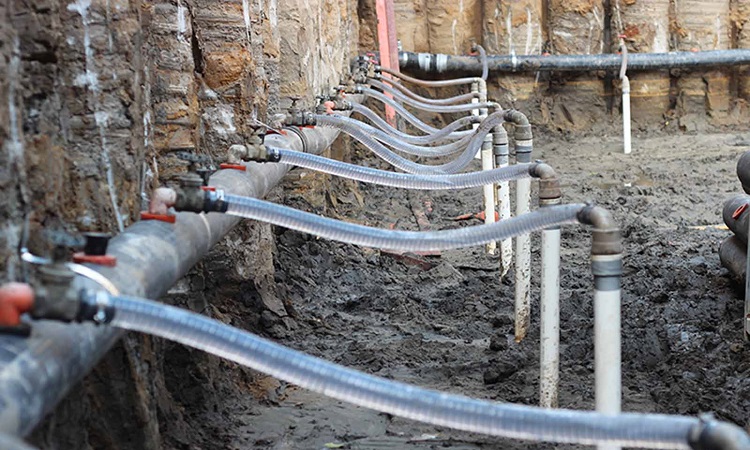Dewatering is the temporary reduction of pore pressures or groundwater levels to provide dry, stable and safe soil conditions in excavations below groundwater level.
On a construction project dewatering is used to facilitate the construction of the deep excavations that are required for foundations, basements, trenches and other underground structures.
Recommended Dewatering Type
As per the site condition install a single stage Well point system to control the ground water within the area of the excavation required to construct the below water table level activities.
Well points are small-diameter (about 50 mm) tubes with slots near the bottom that are inserted into the ground from which water is drawn by a vacuum generated by a dewatering pump. Well points are typically installed at close centers in a line along or around the edge of an excavation.
Well point dewatering involves the installation of riser pipes/tubes with a filter section on the lower 1 meter portion, connected into a common header pipe from which the water can be pumped by a vacuum assisted pump to a convenient discharge point.
Necessary Equipment & Materials
- Hand tools.
- Auger Drilling Machine (Self propelled) – if necessary
- High pressure Jetting Pump (12 to 15 bars)
- 6” Dewatering pump
- 6” Booster pump
- Jetting lance (6.0m long) complete with tank and accessories.
- Stand by Dewatering Pumps
- Stand by Booster Pumps
- Aggregate – 3/10” crushed and pre-washed aggregate.
- Well points – 6m long x 2” UPVC well points.
- Header Pipes – 6m x 6” Galvanized steel header pipe.
- All other pipe network accessories.
Preparations and Preconditions
Permit to Work (PTW) shall be raised for dewatering clearly mentioning the location of work and levels.
Mark and identify the area required dewatering suitable to the area with least interface of new construction activities.
Layout and mark the dewatering system (well point system , suction , discharge lines, storage tank and pumps (Running & Standby).
Required sign boards such as “DANGER” and warning boards will be placed to indicate the work.
Ensure the working area at any confined space is free from any Hazardous Gas by proper Gas testing using the Gas testing instrument.
Check the area prior to drill / bore hole for inserting well points to find out any underground facilities other than listed in topographical survey by:
- Using appropriate detective equipment, such as cable detector, metal detector etc.
- Check existing exposed excavation nearby area to find out existing underground facilities.
- Refer available As-built drawings from the Owner, other agencies , other contractors doing projects nearby areas and marks in the area.
- Take trial/ test pits to find out existing underground pipes, structures.
- Check the indication marks, signs, manholes nearby area and find out the path of services.
Preparation of Working Platform Level.
Initial excavation for all structures shall include an installation platform 50cm above the existing water table.
Pre Drilling (if required)
As a means of ensuring the integrity of the well point installation, boreholes shall be predrilled to the required depth at 1meter intervals. Pre-drilling shall be executed by the use of a self propelled drilling rig.
Well Point Installation
Well points shall be installed into the boreholes at 1meter intervals. High pressure water shall be injected into the ground through the 6 meter lance; forming a borehole into which the well point shall be inserted.
Once the well point is installed the lance is held in this position until the water being ejected out through the top of the borehole runs clean.
The borehole and well point surrounds are backfilled with aggregate (size 3mm to 10mm) which cover the filter section of the riser tubes. As the jetting lance is withdrawn from within the borehole, the aggregate shall reduce to ground level by the displacement created by the removal of the lance.
This procedure is repeated upon installation of each well-point.
The holes drilled by drilling machine and holes shall be cleared or cleaned by jetting of water through jetting pipe connected with jetting pump.
During jetting, the well point pipe shall be inserted up to the bottom of the hole until the jetting water comes through the well point pipe top side to ensure that the installed pipe is free from blockage and pour aggregate (filtering material) around the pipe to filter the water during dewatering.
Header Pipe Network
Upon completion of the installation of the pre determined number of well-points, the well- points shall be connected to the header pipe network by means of swing pipes, which in- turn is connected to the dewatering pump.
Discharge
The collected water produced by the well point dewatering system shall be discharged into a settlement tank prior to discharging into the approved water disposal area as defined by the client.
During discharging the ground water the filter screen with 3/10 mm aggregates minimizes the movement of fines in the water during the ground water discharge, the soil fines movement is monitored via visual inspection in the settlement tank on a periodic basis.
Required drainage channels, troughs, pipes shall be provided to control the discharge of water from dewatering from the site with suitable discharge pump and equipment’s as per the specifications.
Commissioning of Dewatering System
Once complete, the dewatering system shall be started with the approval of the client’s representative. After the first 12 hours of running, all well-point locations shall be observed and adjusted, so that the correct vacuum is created to achieve full efficiency of the system.
The installed well point dewatering system can be modified to a limited degree, header pipes can be disconnected in sections, pumps & discharge hose can be moved. However, any alteration & extension to the system after installation involves stoppage of pumps.
Monitor the dewatering system in a 24 hours’ basis with experienced technicians and additional dewatering pumps.
Discover more from Method Statement Store
Subscribe to get the latest posts sent to your email.